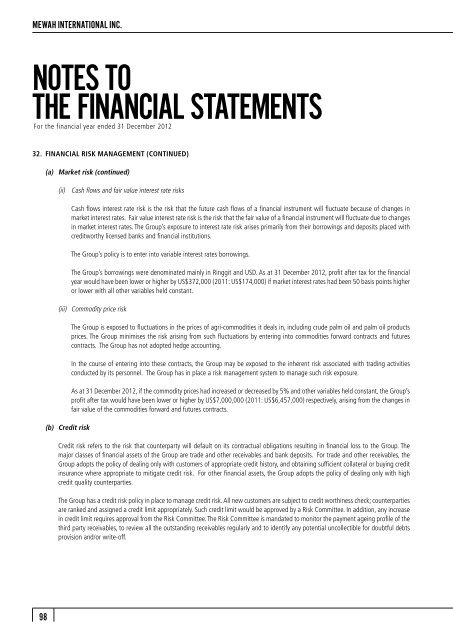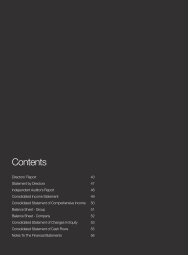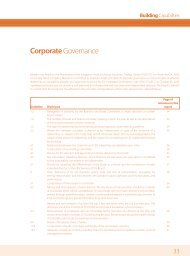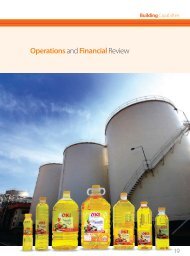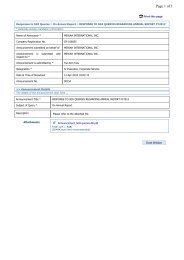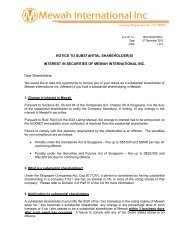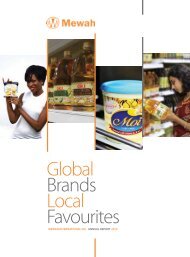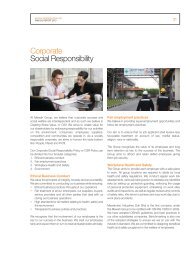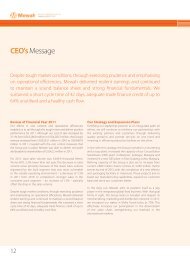FINANCIAL STATEMENTS - Mewah Group
FINANCIAL STATEMENTS - Mewah Group
FINANCIAL STATEMENTS - Mewah Group
You also want an ePaper? Increase the reach of your titles
YUMPU automatically turns print PDFs into web optimized ePapers that Google loves.
MEWAH INTERNATIONAL INC.NOTES TOTHE <strong>FINANCIAL</strong> <strong>STATEMENTS</strong>For the financial year ended 31 December 201232. <strong>FINANCIAL</strong> RISK MANAGEMENT (CONTINUED)(a) Market risk (continued)(ii) Cash flows and fair value interest rate risksCash flows interest rate risk is the risk that the future cash flows of a financial instrument will fluctuate because of changes inmarket interest rates. Fair value interest rate risk is the risk that the fair value of a financial instrument will fluctuate due to changesin market interest rates. The <strong>Group</strong>’s exposure to interest rate risk arises primarily from their borrowings and deposits placed withcreditworthy licensed banks and financial institutions.The <strong>Group</strong>’s policy is to enter into variable interest rates borrowings.The <strong>Group</strong>’s borrowings were denominated mainly in Ringgit and USD. As at 31 December 2012, profit after tax for the financialyear would have been lower or higher by US$372,000 (2011: US$174,000) if market interest rates had been 50 basis points higheror lower with all other variables held constant.(iii) Commodity price risk(b) Credit riskThe <strong>Group</strong> is exposed to fluctuations in the prices of agri-commodities it deals in, including crude palm oil and palm oil productsprices. The <strong>Group</strong> minimises the risk arising from such fluctuations by entering into commodities forward contracts and futurescontracts. The <strong>Group</strong> has not adopted hedge accounting.In the course of entering into these contracts, the <strong>Group</strong> may be exposed to the inherent risk associated with trading activitiesconducted by its personnel. The <strong>Group</strong> has in place a risk management system to manage such risk exposure.As at 31 December 2012, if the commodity prices had increased or decreased by 5% and other variables held constant, the <strong>Group</strong>’sprofit after tax would have been lower or higher by US$7,000,000 (2011: US$6,457,000) respectively, arising from the changes infair value of the commodities forward and futures contracts.Credit risk refers to the risk that counterparty will default on its contractual obligations resulting in financial loss to the <strong>Group</strong>. Themajor classes of financial assets of the <strong>Group</strong> are trade and other receivables and bank deposits. For trade and other receivables, the<strong>Group</strong> adopts the policy of dealing only with customers of appropriate credit history, and obtaining sufficient collateral or buying creditinsurance where appropriate to mitigate credit risk. For other financial assets, the <strong>Group</strong> adopts the policy of dealing only with highcredit quality counterparties.The <strong>Group</strong> has a credit risk policy in place to manage credit risk. All new customers are subject to credit worthiness check; counterpartiesare ranked and assigned a credit limit appropriately. Such credit limit would be approved by a Risk Committee. In addition, any increasein credit limit requires approval from the Risk Committee. The Risk Committee is mandated to monitor the payment ageing profile of thethird party receivables, to review all the outstanding receivables regularly and to identify any potential uncollectible for doubtful debtsprovision and/or write-off.98


